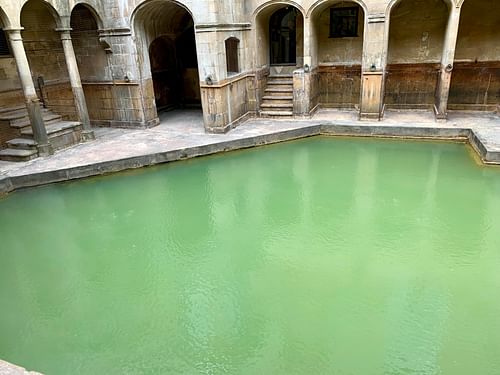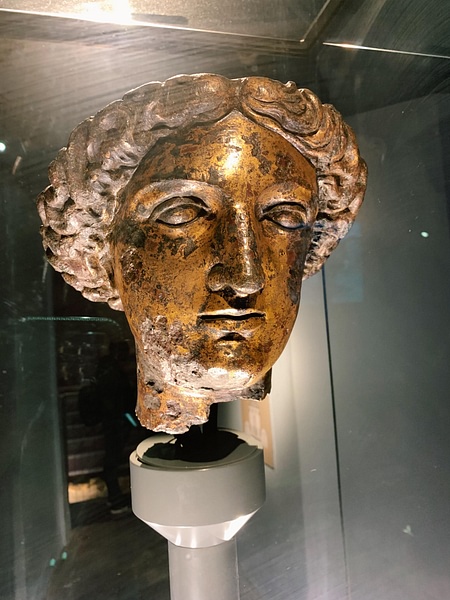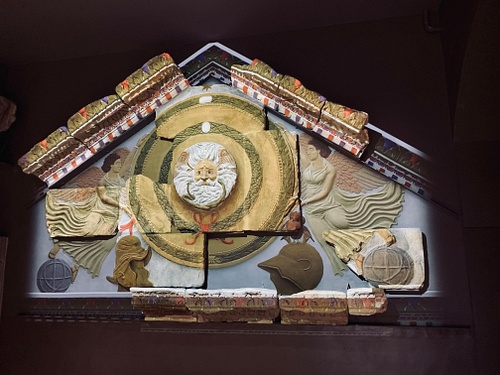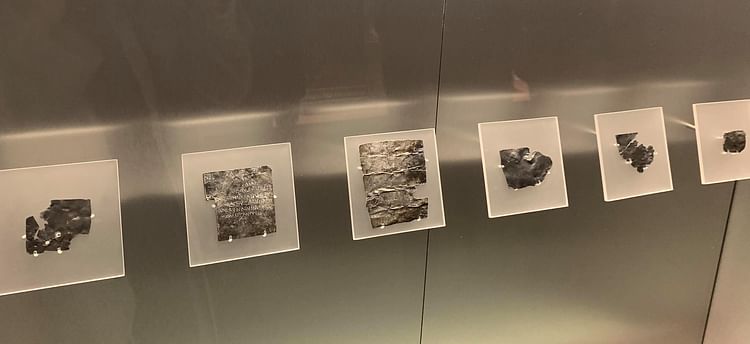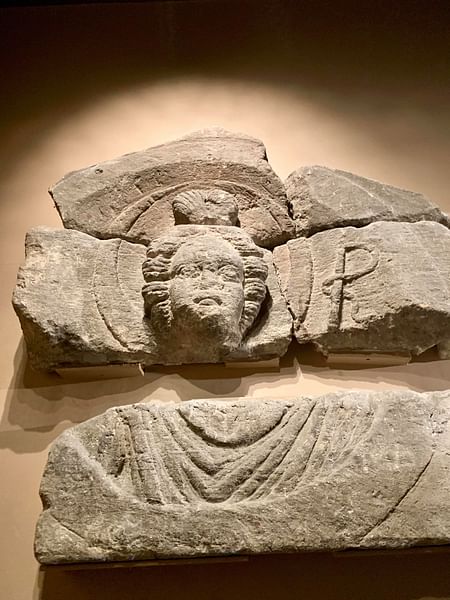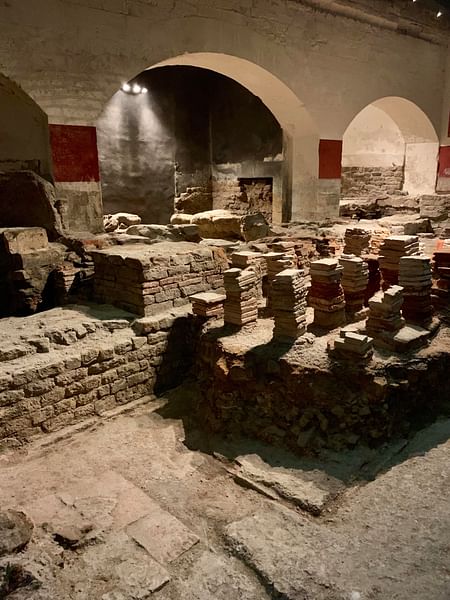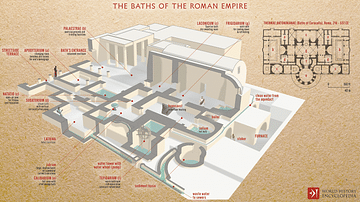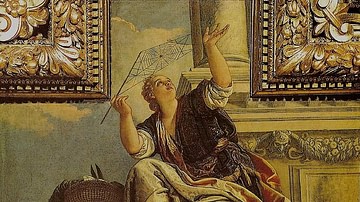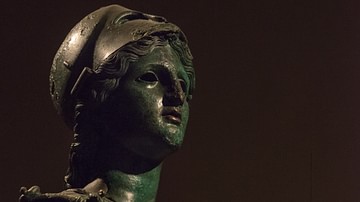Bath, the famous spa town in Somerset England, has attracted people from near and far for centuries to its healing springs and baths. Today the city is known for its beautiful Georgian architecture and as the destination for the wealthy elite of the 18th and 19th centuries CE. The rich and powerful visited the beautiful city to drink the warm, strange tasting water, but the use of the hot spring water also has a much older history.
In the center of the UNESCO world heritage city, you can visit the Romans Baths. Here you can learn about how the hot spring was worshiped and utilized by the Romans who conquered Britain in 43 CE. The Romans constructed a temple and bath complex in honor of Sulis Minerva, a Romano-Celtic composite of Sulis, the Celtic goddess of the healing and sacred water, and Minerva, the Roman goddess of wisdom. In a few decades, the city of Aquae Sulis emerged around the bath complex as one of the most important spa and pilgrimage sites in the western part of the Roman Empire. Visiting the once-forgotten Roman Baths will give you insight into the ancient city's long history, and it is also one of the places in England where you can learn a lot about life, religion, and changes in the society of Roman Britain.
A visit to the Museum of the Roman Baths gives you access to the remains of the impressive ancient bath complex, as well as the museum's collection of finds from excavations and conservation work.
The Romans & The British Isles
To the Romans, the distant Isles to the west were separated from the known world by the great river Ocean also known as Oceanus, which was encircling the world. The Roman generals and emperors who first explored and conquered this unknown land took pride in overcoming the great Ocean and the dangers contained in its deep blue waters.
Julius Caesar (l. 100-44 BCE) was the first Roman general who tried to conquer the barbaric and uncivilized island dwellers in the 1st century BCE. He established the first contact between the Romans and the different British tribes around 55 BCE, but they were not defeated until the year 43 CE when Claudius (r. 41-54 CE) ruled as the fourth emperor of Rome.
Only a few decades after most of the island was conquered the impressive bath complex at Aquae Sulis was built and in full use by Romans and locals alike. The first record referring to the bath dates to the year 76 CE, and it is believed that the bath and temple buildings had already been standing for a while at this time. The Romans were quick to discover this sacred and healing site and transformed it into one of the symbols of Roman civilization: the public bath.
Dedicated to the local goddess Sulis, a personification of the healing water, the site was most likely a holy grove to the locals and possibly the mysterious Druids (thought to have been the wise men - possibly also women - and spiritual leaders of the ancient British tribes but of whom little is actually known) for centuries before the Romans arrived. According to an ancient legend, the healing hot spring was discovered by Prince Bladud in 863 BCE. The prince was banished from his kingdom as he suffered from leprosy and traveled through the countryside with his pigs. When the pigs, infected with the same disease, rolled around in the mud in the area now known as Bath, they were cured of their infections and the prince discovered the hot springs and its healing powers. He cured his disease, became king of his entitled kingdom and founded a city at the site of the healing water.
There is little evidence remaining from the pre-Roman worship, as they left little footprints of their spiritual practice for us to study. It is believed that the practice of building temples and sculpturing the gods and goddesses they worshiped was not a part of the ancient British religion. This change in religious practice is one of the most visible changes that accrued when the Romans entered the island. The religion in itself changed as well, as the locals adopted the Roman gods. However, this transformation was more of a “two-way street” where the Romans also adopted the local divinities, or merged them together, as with the goddess worshiped at Aquae Sulis: Sulis Minerva. The Romans who discovered the site most likely thought that the local goddess held the same powers as their own Minerva, the goddess of wisdom, medicine, commerce, handicrafts, poetry, the arts, and later, war.
The Ancient Bath
Entering the Roman Bath Museum, the first thing you lay your eyes upon is the Great Bath, the largest attraction in this huge complex. You will first get a good view of the now roofless pool as you walk along the high walls and terraces built so that the public could visit the site. Here you can learn some general information about the discovery of the bath in the 18th century CE and the museum. Information is available to read at the information boards all through the museum, but you will also have been given a free audio guide at the entrance, which will give you additional exciting information.
As mentioned, the bath complex was built around the middle of the 1st century CE, and the Great Bath, together with the temple and the sacred spring would have been the main attractions in Aquae Sulis. The Great Bath hall was a marvelous example of Roman architecture and engineering as the roof would have been 20 meters above the bath. There is no roof now and so the water is green due to algae that grow in the sunlight, which would not have been the case in ancient times. You can also see statues of the Roman generals and emperors whose policies and strategies impacted on the British Isles. The statues were fashioned by British sculptor George Anderson Lawson (1832-1904 CE) and are positioned on the terrace overlooking the bath.
After enjoying watching the Great bath from the terrace for a while, you move on to the main part of the site: the Hot Spring. The Hot Spring is what made the site so important and mysterious to the Britons and Romans, as the water in the spring rises at a rate of 1,170,000 liters each day with a temperature of 46°C. Watching the water, you can see the damp and gas bubbles leaving the surface, and it is not hard to understand why the ancient inhabitants saw this as the work of the supernatural world. Surely the water's healing power was a gift from the goddess Sulis.
The Roman Britons & The Temple
Next up is the museum part of the Roman Baths, where you can learn more about the lives of the people who lived in Aquae Sulis and the people who traveled there from all over the Roman Empire to be healed by the magical water.
As you enter the museum, some of the earliest discoveries made on the site can be studied. The earliest finds are coins that date from before the Romans built their magnificent bathhouse. The local tribes - the Dobunni and the Durotrigesis - threw the coins, styled with imagery of ships, human heads, and triple-tailed horses into the sacred spring as offerings to the goddess.
Many of the finds from the Roman period are items that belonged to Roman soldiers and craftsmen who traveled with the army. The soldiers were naturally the first Romans to settle in and develop what would become Aquae Sulis, and some of their tombstones are on display in the museum, giving the visitor some insight into their life and background. The remains of a statue depicting a boar may provide further information about who the first soldiers at Aquae Sulis may have been. The boar was the symbol of the 20th legion, which makes it probable that the soldiers of this legion participated in the building of the baths.
When the bath was established, pilgrims and tradesmen also traveled, settled or unwillingly ended their days in Aquae Sulis. On display are the remains of a man who for some unknown reason traveled the long way to the healing baths. The DNA test shows that he was probably born in the Levant region – a long way from Britain in the ancient Roman world. With all the visitors to the baths and the new settlers, the city must have been what today is often called a multicultural city, where new, old, near and distant cultures met and merged.
The most important aspect of Aquae Sulis was clearly its healing and religious significance, and this is visible as you walk through the museum. One of the most iconic and mysterious objects is the temple pediment, which was located at the front of the Temple of Sulis Minerva. The pediment is a carving of a gorgon's head- thought to be a “male Medusa” surrounded by hair, wings, and possibly snakes. Gorgon's heads are linked to Minerva and her Greek equivalent, Athena, as she carries the gorgon symbol on her shield and/or armor.
The theory that it is a gorgon head protecting the temple of Sulis Minerva is feasible, but no one knows for sure what the carvings are meant to symbolize, and debates are still ongoing amongst academics. The carving was produced in the Roman era but was most likely done by local craftsmen. It is therefore not unlikely that the imagery is a mix of Roman and Celtic mythology and symbolism. As you sit down and admire the beautiful carving, which also at times is lit up in its original colors, it is intriguing to speculate what meaning the mysterious gorgon man had to the visitors of the temple nearly 2000 years ago.
Other religious artifacts of great interest that can be viewed in the museum are the curse tablets and a religious mask. The mask is made of tin and was found in the drain of the sacred spring - it was possibly used in processions by a priest. The curse tablets are messages that were written on lead or pewter and thrown into the sacred spring. The visitors would ask the goddess for help and Sulis was also often asked to punish some known or unknown thief who had stolen the personal belongings of the tablet author. Due to their historical significance, the tablets are inscribed on the UNESCO Memory of the World register of significant documentary heritage.
As you continue to walk through the museum you enter the site that was the temple courtyard. Even though the site is now in ruins, it is not hard to imagine what the sacred site must have looked like in its heyday.
On each side of the courtyard, there were two temples facing each other: one temple was dedicated to Luna, the moon goddess, and the other to Sol, the sun god. The carving from the pediment at Luna's temple is still preserved and can be viewed in the museum. Luna was the Roman goddess who was the embodiment of the moon, and on the carving, the moon is clearly visible behind her head as she also holds some kind of staff. The staff looks similar to the Rod of Asclepius, which has led some academics to suggest that her temple served as a place for healing of the sick and wounded.
In the center of the courtyard was the sacrificial altar. The altar is still partly standing, carved with some of the ancient gods and goddesses. In Aquae Sulis this was the place for public worship. Ceremonies as animal sacrifices would have taken place on these altar stones. When you pass the altar, you will see the site where the temple of Sulis Minerva once stood. It was the most important building in the temple courtyard. The temple could not be entered by the general public - only the priest of Sulis Minerva - but the golden statue of the goddess was likely visible through the open door. The gilded bronze statue of Sulis Minerva would have been of great importance to the people living and traveling to the healing site. The head of this golden statue is all that is left as it was deliberately hacked from the body at some point in antiquity. But it is magnificently beautiful.
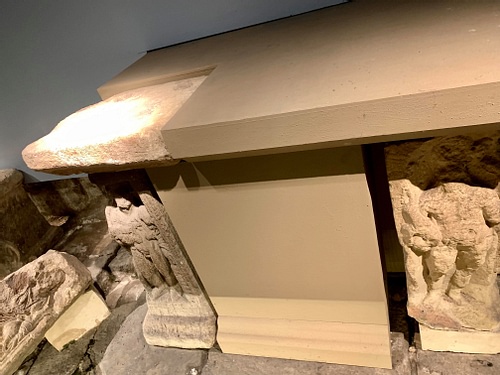
As you enter back into the bath complex from the ground level, you will be able to view the Great Bath more closely. You can also visit the other rooms of the bath; the apodyterium (changing room), the tepidarium (warm room), the caldarium (the hottest room), rooms with smaller baths, one with a large swimming pool, and lastly, a room for treatments and massage. In Roman times, women, men, rich and poor walked these halls and swam in these pools. Envisioning their lives, the interactions that took place here, and the Roman Britons' relationship with the sacred spring and the goddess is limited only by the visitor's imagination.
Before you leave do not forget to get your dosage of the healing water, which has attracted pilgrims for millennia. At the exit is a fountain where you can sample some of the water. Although it is lukewarm and not very pleasant to drink, it might heal all your illnesses as legends claim, and surely this is worth a try.


